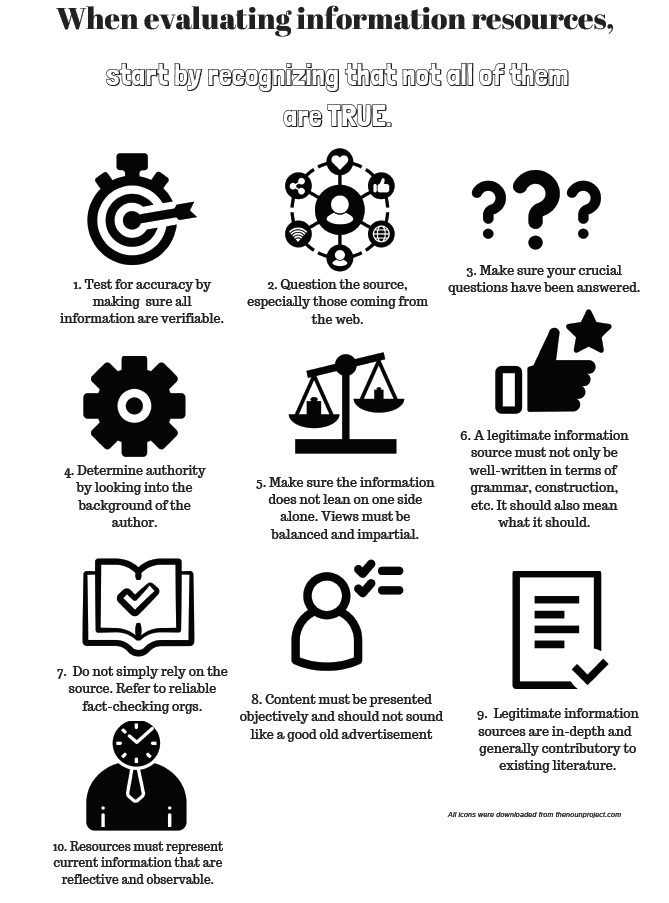We live in a very sophisticated society wherein dissemination of information exponentially flies across all platforms or media so fast, yet verification of the trustworthiness of the same is wanting. So how do we know for sure if the news or information we got from different sources is true and reliable?
This infographics from the Information Services and Instruction Section headed by Ms. Rizalyn V. Janio of the University Library in UP Diliman is very helpful and we would like to share this relevant information in light of current events.
When evaluating information resources, start by recognizing that not all of them are TRUE.
1. Test the accuracy by making sure all information are verifiable.
Check the dates and time when the article was published, the place and name of the event mentioned and other pertinent information to check the veracity of the report.
2. Question the source, especially those coming from the web.
The web will make or break you. Be aware of the websites that just mimic the legitimate ones. Check if the source is just a very recent entity and does not hold any credibility yet. For academic researchers, it is advisable to refer to “.edu” sites.
3. Make sure your crucial questions have been answered.
Be guided by the “Who, When, Where, What, Why, and How” questions. Does it answer your questions in mind? Or the article just muddled the already complicated issue?
4. Determine authority by looking into the background of the author.
Credibility is very important. You have to check the personal leanings of the author and consider his political, religious, and personal beliefs. Is he just a propagandist to advance somebody’s agenda?
5. Make sure the information does not lean on one side alone. Views must be balanced and impartial.
This is very important. A balanced news takes all sides.
6. A legitimate information source must not only be well-written in terms of grammar, construction, etc. It should also mean what it should.
This is on point. Trolls are paid hacks and they don’t mind checking all the grammar lapses they made. Legitimate information just present facts for facts sake.
7. Do not simply rely on the source. Refer to reliable fact-checking orgs.
Fact checking prevents misinformation. Two media organizations, VERA Files and Rappler IQ, are fact-checking organizations recently accredited by Facebook to check on information.
8. Content must be presented objectively and should not sound like a good old advertisement.
Objectivity should be prioritized over the commercial appeal of information presented. As with tip #6, let us look for factual information and not mere advertisements.
9. Legitimate information sources are in-depth and generally contributory existing literature.
Information is a very powerful weapon. It becomes part of our history as it adds to the general body of knowledge of the area or genre it belongs to.
10. Resources must represent current information that is reflective and observable.
This is not to diminish the importance of historical information, but in some areas, current information may supersede previously published ones, such as in legislation.

Disclaimer Regarding Accuracy of Information and Usage of Data Visitors and users of the UP ISSI website are advised that information contained within the website is assumed to be accurate. However, errors can occur even with computer-generated information. UP ISSI makes no representation regarding the completeness, accuracy, or timeliness of such information and data, or that such information and data will be error-free. Visitors are encouraged to review the official version of all documents on which they plan to rely on.